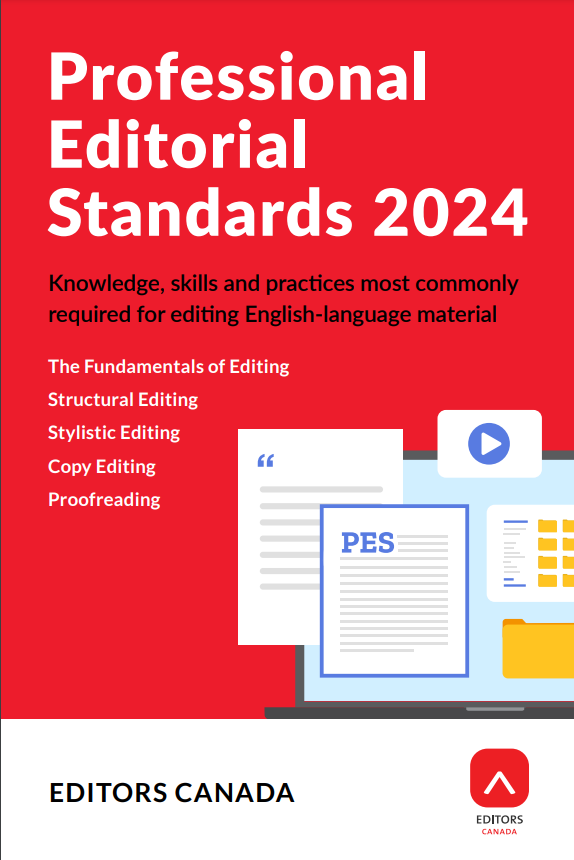Editors Canada's updated Professional Editorial Standards move our profession forward.
Putting a price on your work
 There’s been a lot of fresh chatter recently among editors about rates. Maybe it’s because at this time of year we’re all looking over our accounts, reviewing how much we did—or didn’t—earn, paying bills, planning for the next 12 months, wondering what we can do to realize a higher return.
There’s been a lot of fresh chatter recently among editors about rates. Maybe it’s because at this time of year we’re all looking over our accounts, reviewing how much we did—or didn’t—earn, paying bills, planning for the next 12 months, wondering what we can do to realize a higher return.
This conversation hasn’t changed much in all the years I’ve been in the biz. For the first 15 years of my career, I worked inhouse for a trade publisher that paid competitive salaries for the industry, which means “not very much.” It was my responsibility to hire freelancers, and I apologized to all of them because we offered such a low hourly rate—but no lower than any other trade publisher did.
I’ve been self-employed now for longer than I worked inhouse, and I’ve learned a few things over the years about what and how to charge for my time and earn what I believe I’m worth. The main lesson is that we editors don’t have to allow ourselves to be controlled by the low end of rates, or as Iva Cheung laments, “trapped underwater by the anchor of trade-publishing rates.”
I believe the first step to earning what you’re worth is to stop defining yourself as an editor. Instead, think of yourself as a business person, one who offers editorial services. As a business person, you need to determine what it takes to make your business survive and thrive. Don’t start by asking, “How much do editors charge?” That question hands control over to someone else. Instead, ask, “How much do I need to charge?” It surprises me how many self-employed editors don’t start at this point, which is fundamental to any enterprise. Without that knowledge, you are flying blind.
You can find detailed advice on how to determine that magic number in various business books, websites, and blogs. Richard Adin points to several sources in his helpful posting that speaks specifically to editors and rates, and Editors BC is offering two timely, relevant workshops on the subject later this month.
In short, you must figure out how much you need to pay all the bills and have money left over—keeping in mind that profit isn’t a dirty word, and yes you do deserve a vacation or two. Once you have that figure, you can calculate your hourly rate by dividing by 1,000. (Experts advise that no matter how efficient you are, you won’t be able to work much more than 1,000 billable hours a year.)
If your calculated hourly rate is higher than what some of your clients are willing to pay (and it will be), it’s time to start making some smart business choices. Here are a few to think about.
1. Mix your client base
Choose to limit how much you work for lower-paying clients. I still love working on trade books and with the people in that industry, all of whom I have great respect for. I also know that book publishers and other small organizations with very limited budgets don’t have much room to manoeuvre. They need to make their own costing decisions based on their business, not mine. So, I pick and choose the projects I accept to meet my target earnings. There’s nothing wrong with the high-paying clients providing you with the means to sometimes work for lower-paying ones!
- Risks: Sometimes, in finding those higher-paying clients, you may find yourself stepping out of your comfort zone, working on subject matter or in an industry that is new to you, and wondering whether you can do your best work. As long as you’re clear with the client about what you can deliver, any other risk is theirs, not yours.
- Benefits: You will learn something new, which will deepen your skills and broaden your potential client base for future work.
2. Charge the same rate for all services
Typically, editors charge less for proofreading than copy editing and less for copy editing than substantive editing. Why? The way I see it, an hour of my time is an hour of my time. This concept became a line in the sand for me several years ago. Different clients may pay me different rates, but I ask for the same rate from a client no matter what service I am providing. Sometimes I get pushback, but generally I’ve found clients accept my approach after I’ve politely, professionally stated my case.
- Risks: The client won’t accept your one-size-fits-all rate. (But you won’t know that if you don’t try. The client may want to negotiate, but it’s unlikely you’ll be met with a flat-out no.)
- Benefits: You get what you asked for! Or, even if you don’t, you’ve taken a step toward educating the client about realistic rates.
3. Charge rush and weekend rates
This is another principle I now firmly apply. If a client calls me at 3 p.m. on Friday asking me to have a job done by 9 a.m. on Monday, I’ll make it clear I’ll be charging time-and-a-half. Clients who need work done that fast generally recognize it comes with a price.
- Risks: The client says no and you lose the job. (But that’s unlikely, because in these cases clearly the client has few choices.)
- Benefits: You get the job and are paid handsomely for it. Or you get the job, but the client extends the delivery date by several days. Win-win. You still get the weekend; they get the work done.
4. Leave the freelance world
I know this won’t be your first choice, but maybe it’s what you have to do for a time. Self-employed life isn’t for everyone, and if you have household and family financial constraints, and no second household income earner who can help fill the coffers, an inhouse job with a secure, constant income stream and health benefits can relieve a lot of stress. The freelance life will always be out there if that’s what you aspire to.
* * *
Wishing it were different is not a choice
I wish that trade book publishers paid editors more. I wish that those publishers, seeing me choose to work for other, higher-paying clients, would wake up and say, “Look what we’re missing by not hiring that amazing, talented editor! We must change our rates today!” I wish that book publishing wasn’t such a marginal business for the owners, who rely largely on sales from bookstores, a segment of the industry with even tighter profit margins. I wish that all organizations had the budget to pay editors what they are worth. I even wish that I didn’t have to think about all this and that every one of my clients would offer a high rate before I opened my mouth, freeing me from those selling tasks I don’t particularly enjoy.
But wishes don’t run a business. Actions based on well-considered decisions do. Individually, you must take the steps that work for you and your business. Together, we business owners need to keep promoting the editorial profession, educating clients of the value of our services, and supporting each other in sharing resources and knowledge.
This Post Has 5 Comments
Comments are closed.




Excellent article, Ruth, and I appreciate the link to my An American Editor blog. My perspective differs a bit from yours (not radically) but there is one omission that I feel obligated to point out: efficiency.
Efficiency is important because it impacts on rates. Struggling to increase rates in a globalized profession is difficult. Efficiency offers an alternative route to getting that increase.
Every business – whether it be selling groceries, buying minerals, or editing — requires efficiencies to be profitable as the world contracts and competition arises. The lament about low pay is far from new. I am entering my thirty-third year as a freelance editor and the lament has not changed. More importantly, the lament hasn’t changed because the rate of pay hasn’t changed. I am being paid today exactly what I was being paid 25 years ago. And if the major publishers could go lower they do, which is why the offshoring of editorial and production services to countries like India.
Yet, I, like most editors, want to increase my income and my living standard.
The key, I discovered early on is found in efficiency, that is, investing in those things that will make my work more efficient and thus me more productive. This requires an honest evaluation of every aspect of one’s business. Two simple examples:
(1) PC or Mac. This “controversy” gets approached from multiple angles but rarely from an efficiency angle. When I started freelancing, it was the early days of computers and Macs were light-years ahead of PCs in many ways — but not in the most important way for me. No matter how I twisted and turned, PCs were superior to Macs because anyone could write a program for a PC or create an add-on or replacement that improved the computer. That could not be done with a Mac, which is tightly controlled. What that meant was that if I needed a macro to improve efficiency, it was much easier to write it myself or hire someone to write it for me if I was on a PC. It also meant that I could custom build my computers to maximize efficiency for the way I work, rather than accept someone else’s perspective. So, for me, the decision was PC. Every 4 or 5 years I have reviewed that decision and found that nothing has changed. Macs are great computers, but not for me for the way I work or for my particular needs. But I know that from careful evaluation, not because someone once told me that Macs are less vulnerable to xyz, which is important but not dispositive because PCs can also be made less vulnerable.
(2) The second example is investment in tools to improve efficiency. An example here is my EditTools macro program. I spend a lot of money every year on having macros written for me and incorporated into EditTools. But I learned decades ago that what I was really investing in was my own profitability. Consider just my Journals macro, which is part of EditTools. I regularly work on manuscripts that have between 500 and 1,000 references per chapter and a lot of chapters (e.g., my current project is more than 80 chapters and runs over 13,000 manuscript pages). Every reference has be checked for completeness and every journal name has to be correct and fit the client’s required style. No matter how smart we are, there is a limit to how many journal names and abbreviations we can retain. Consequently, we have to spend a lot of time verifying that whatever abbreviation the author has used is correct. With my Journals macro, I can check the journal names of 1,000 references in less than 30 minutes. Based on studies I did, I know that saves me between 5 and 8 hours of time. Yet, I receive the same pay (because I charge by the word, not by the hour; charging by the hour is the least-efficient method), which means I have increased my efficiency and my profitability.
The point is that investment in existing programs or in creating yourself appropriate programs is a way to increase efficiency, yet few freelancers do so. What they see is money going out; they look at the very short term rather than the long term. Editing is my career, not a 3-month gig. Consequently, when I decide to invest in something like my EditTools, I make the decision not on how it will pinch my finances this month, but what it will do to my finances over the course of my career.
The perspective of efficiency is key to a successful career as a freelancer, no matter what the freelance occupation. This is the most important discussion missing from your article: The willingness to invest — whether it be time or money or both — in those things that will increase your efficiency and thus your profitability.
Thank you, Richard, for your valuable addition to my comments. I couldn’t agree with you more about efficiency, especially with macros. Years ago, when I was still inhouse and we moved from paper-based editing to computers, the first software program I edited on was Xywrite, a dos-based program that was light-years ahead of Word, as it allowed users to easily customize it for their own needs. Its macro capability saved us hours of time, as the copy editors, in those early days of desk-top publishing, were assigned the task of coding the various level headings. I got so good at it that I could chat on the phone with an author while tagging a manuscript with the macros. Alas, Xywrite is no longer, not being able to compete with the big guns as software developed. But, as you indicate, there are many other efficiencies any business person can—and should—adopt.
Nice work, Ruth.
You are absolutely right, Ruth. This is a business. To treat the work any other way is to do yourself a disservice.
Many business people I’ve met over the years (including writers and editors) are so wrapped up in the incredible, world-stopping, never-seen-before product they are offering, they forget the marketing, the business management and, yes, the profits that are necessary to make it viable.
Also, another perspective on pricing. . .
I know many of my editing friends work on long documents (generally, I do not) and books so this may not apply across the board but I take a different approach to pricing. I do not charge by the hour. Instead, I offer a project rate. There are no surprises for the client when the bill comes and I generally do far better than I would have if I had charged by the hour.
Having worked in this business for more than three decades, I am confident that I can come fairly close on determining the effort a given project would take. I’ve also become good at finding the pinch point, that is, the maximum price I can charge that matches, in the client’s mind, the value I am bringing to the table. So, project pricing works for me.
Regarding Macs and PCs, I’ve been a MacHead since 1986. I’ve never been stuck or found myself to be inefficient—certainly not these days—in the Mac environment.
Lest you think I am one of those give-me-Mac-or-give-me-death guys, I am most definitely not. In fact, I’m looking at getting a PC now as the quality of Mac products has taken a nosedive since about 2005. Pity, really.
Thanks, Ron. I won’t weigh in on the Mac vs PC debate, having never worked on a Mac, but I’ve certainly been witness to the debate over the years.
As for charging by the project, I agree with you, and I do that whenever I can. Even when clients insist on an hourly rate, I also provide a quote for the total time I’ll be billing so they know what the bottom line will be on my invoice. (Another key business skill required: learn how to estimate accurately.) However, I do find that I still have an hourly rate in my head when quoting by project, because I find that the most straightforward way to work toward my target earnings goal.
Ron, since I raised the Mac vs. PC issue, let me reiterate that my point is that one should not buy either without first determining which one will enhance their work efficiency for the way that they work. In my case, for example, I could not be as profitable as I am in the absence of certain custom programs I use. These programs are PC-only. But, and this is a big but, the programs are specifically designed to make the kinds of projects I do (very large texts, not short documents) more profitable. In addition, I have a very specific, self-designed system of hardware that ensures that no virus or malware can put me out of business for more than about 15 minutes. Although the programs could be run on a Mac using Windows simulation, why run Windows on a Mac? The hardware protection solution I use is simply not possible on a Mac. So when I weigh the pros and cons for my business, PC wins. I have plenty of friends who prefer the Mac solution because it better fits their methods. The issue is simply one of evaluating both and choosing the one that improves efficiency regardless of its label.